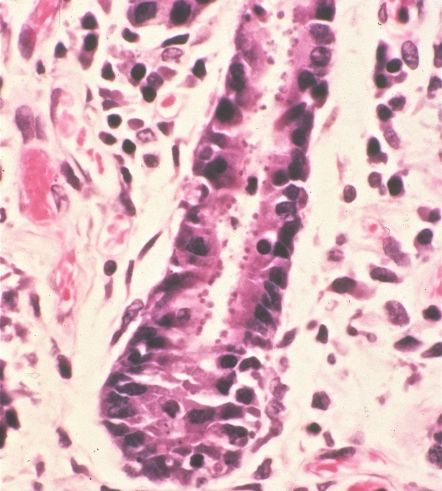A 52 year-old male with HIV presents with profuse, watery diarrhea of 5 days’ duration. A biopsy of the small intestine is shown here.
What is the most likely diagnosis?
A. Cryptosporidium
B. Giardia
C. Acanthamoeba
D. Toxoplasma
E. Histoplasma
(Scroll down for the answer)
The causative organism in this case is cryptosporidium, a teeny tiny protozoan that is pretty hard to see until someone points it out to you for the first time. For that very reason, it frequently makes an appearance in pathology “unknown” conferences (where they give you a tray of slides, a little history (maybe), and them pimp you mercilessly for a diagnosis. The first year residents (or medical students) will often miss it since the organisms are minuscule and can be sparse. Once you’ve seen it, though, then you’ll remember to look for it the next time.
Cryptosporidium mainly affects children, in whom it causes either self-limited or persistent diarrhea. It also affects patients with AIDS, in whom it causes severe, chronic diarrhea. The organism is highly infectious, and is spread by fecal-oral transmission.
Diagnosis may be made on acid-fast examination of the stool, in which cryptosporidial oocysts are visible as round, red-staining structures. Histologic examination, which is usually not necessary for diagnosis, shows tiny round organisms projecting from the brush border, as seen in this image. Treatment involves antiparasitic therapy and nutritional support.
If you liked this case, and want to test yourself with other unknown cases, here are some to try:
Case 1: 20-year-old male who died suddenly
Case 2: 72-year-old male with right calf mass
Case 3: 67-year-old female with pancytopenia
Case 4: 59-year-old male with severe headaches
Case 5: 38-year-old female with deep venous thrombi
Case 6: 13-year-old male with cerebellar mass
Case 7: 45-year-old male with pulmonary emphysema
Case 8: 38-year-old male with AIDS and headaches
Case 9: 25-year-old male with arm mass
Case 10: 57-year-old male with fatigue and left upper quadrant heaviness
Case 11: 62-year-old male with hepatosplenomegaly, skin lesions and cardiomyopathy
Case 12: 16-month-old infant with failure to thrive
Case 13: 36-year-old female with painless lower leg nodule
Case 14: 58-year-old female with several-year history of pelvic pain
Case 15: 52-year-old male with abdominal pain and bloody diarrhea
Case 16: 42-year-old female with tinnitus, hearing loss, and a mass at the cerebellopontine angle








Recent Comments